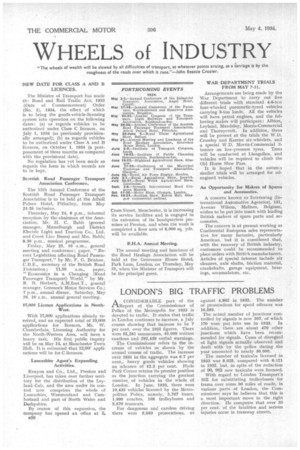LONDON'S BIG TRAFFIC PROBLEMS
Page 34

If you've noticed an error in this article please click here to report it so we can fix it.
CONSID pa ERABLE rt of the AReport of the Commissioner of Police of the Metropolis for 1933 is devoted to traffic. It states that traffic in London continues to increase, a July census showing that increase to be 7 per cent, over the 1931 figures. There were 55,281 summonses, 40,509 written cautions and 292,439 verbal warnings.
The Commissioner refers to the increase of vehicles as shown by tlie annual census of traffic. The increase over 1931 in the aggregate was 6.7 per cent., heavy goods vehicles showing an advance of 42.3 per cent. Hyde Park Corner retains its premier position as the junction carrying the greatest number_ of vehicles in the whole of London. In June, 1933, there were 10,433 vehicles licensed by the Metropolitan Police, namely, 5,767 buses, 1,990 coaches, 108 trolleybuses and 2,570 tramcars.
For dangerous and careless driving there were 6,050 prosecutions, as
against 4,862 in 1932. The number of prosecutions for speed offences was 16,693.
The actual number of junctions controlled by signals is now 207, of which 170 were put into use in 193$. In addition, there are about 470 other junctions which have been recommended for signals. Cases of disregard of light signals actually observed and dealt with by the police during the year amounted to nearly 30,000.
The number of taxicabs licensed in 1933 was 8,025, compared with 8,121 in 1932, but, in spite of the reduction of 96, 962 new taxicabs were licensed.
With regard to London Transport's Bill for substituting trolleybuses for trams over some 90 miles of roads, in various parts of London, the Commissioner says he believes that this is a most important move in the right direction. He computes that over 33 per cent, of the fatalities and serious injuries occur in tramway streets.




























































































